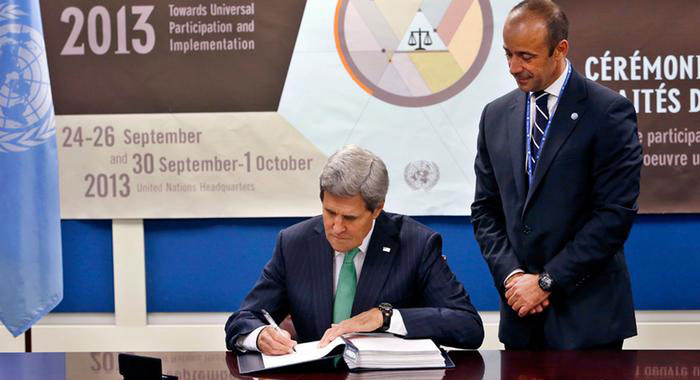
Arms Trade Treaty: How far from expectation?
Sultana Yesmin | Tuesday, 26 November 2013

Following the dire need for non-proliferation of both nuclear and conventional weapons, world leaders -- mostly from the West -- have come forward to build a 'nuclear weapons-free world' by agreeing to an international arms trade treaty. This year, the United Nations General Assembly (UNGA) has also launched Arms Trade Treaty (ATT) in order to regulate international trade of conventional arms ranging from small to highly sophisticated weapons and international arms transfers. The ATT also aims at monitoring export and transfer of conventional arms, ammunition and certain weapon components, as well as combating illicit trade. One of the key objectives of the treaty is to promote regional and international peace and security as well as reduce human sufferings around the world.
It is to be noted that, historically, a number of efforts were also taken to control global arms trade. In the wake of the World War I, for example, the League of Nations attempted to initiate such a plan, but ultimately it failed to make arms treaty obligatory for the member nations. That effort to launch a formal campaign for arms control did not succeed because it did not gain due acceptance from the member countries except only three.
The ATT is a multilateral treaty requiring all signatory states to submit annual reports to the United Nations about international transfers of categorised weapons as well as all authorised arms exports. It consists of twenty eight articles for making all of its provisions obligatory for the contracting state parties.
The ATT was passed by the UNGA with an overwhelming majority of 154 votes on April 3, 2013. The United States signed the ATT on September 25, 2013. The treaty will enter into force only after the ratification by at least 50 countries. So far, only six countries have ratified the treaty, whereas around 108 countries have signed it. A number of European countries are in the process of ratifying it.
Bangladesh appears to be the first country from the South Asian region that has signed the treaty to control trade and use of weapons of mass destruction. Bangladesh Prime Minister signed the ATT on September 26, 2013 at the UN headquarters. Malaysia, the Philippines and Mongolia have also signed the treaty but most of the countries in South and Southeast Asian regions have not yet signed it.
Despite these developments, implications of the ATT for the future remain questionable. Though the USA has signed the treaty and Germany has ratified it, the world's leading exporters of conventional weaponry like China and Russia, and the world's largest arms importer, India have not yet signed the treaty. These countries have abstained from the vote. In addition, Iran, North Korea and even Syria voted against the treaty at the United Nations General Assembly on April 2, 2013. Some other countries have neither supported nor agreed upon the principles of the treaty. These countries are arguing that most of the provisions of the ATT lack effective criteria for preventing supply of weapons to unwanted end-users, such as the terrorists.
The Russian permanent envoy to the UN, Vitaliy Churkin, said, "some of the provisions of the ATT could be misinterpreted and used by some countries for political ends, or as an instrument of commercial competition." China has argued in the same fashion. From the Indian side, it has been argued that the treaty fails to address India's concern of security and also falls short of proper and clear guidance for universal adherence due to the lack of 'balance of obligations' between arms exporting states and the importers of arms. India has also reiterated its 'unpleasant' experiences with the Non Proliferation Treaty (NPT) and the Comprehensive Test Ban Treaty (CTBT) in the past.
These countries also raise concerns about the lack of clear provisions to impose restrictions on the proliferation of weapons to terrorists, non-state actors, armed rebels, insurgent groups and infrastructural inadequacies to monitor illegal arms trade.
In these circumstances, it has been a major issue of concern that how far the world is from disarmament and nuclear-weapons-free regime. All of these challenges have raised concerns about how many countries would ultimately ratify the treaty. In the South Asian region itself, the two nuclear powers are accelerating arms trade for the purposes of ensuring their strengths and preventing both internal and external security threats. China, Russia, Iran, Syria will also increase conventional arms trade in order to compete with bitter enemies and enhance their national security. On the other hand, North Korea has repeatedly ignored to be included in any binding principle on the reduction of arms and nuclear weapons.
So, will South Asia be a nuclear-weapons-free region? How is it possible to ensure disarmament in the world at a time of mounting mistrust and conflict among the nations? It is true that human security will severely be threatened, especially in the developing countries, due to the proliferation of the weapons of mass destruction. Simultaneously, it is also obvious that the world will experience proliferation of conventional weapons due to the lack of cooperation among the nations.
However, the of Arms Trade Treaty is indeed a significant step towards global peace and security. One of the major landmarks of the treaty is its signing by the USA, the largest arms-exporting country in the world. Many experts hope that the United States' signing the ATT will inspire other world leaders to enliven hopes for a nuclear-weapons-free world. Another key positive aspect of the treaty is that Germany, the third largest global arms trader, has ratified it.
The writer is a research assistant, Bangladesh Institute of Peace and Security Studies (BIPSS). sultanayesmindu@gmail.com